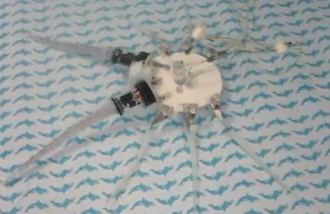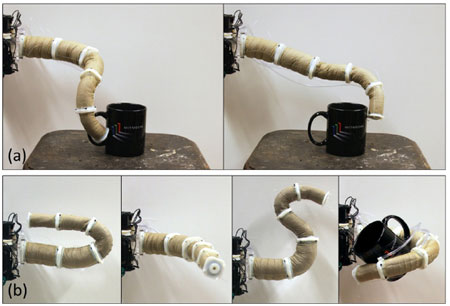
Is there a better model than the human hand for grasping things? Look around the animal kingdom and consider other options. Two immediately come to mind: tentacles as in those we find on octopus, nautilus and squid, and trunks as in elephants. Common to both tentacles and an elephant’s trunk is the lack of an internal bony structure. Instead these animals use muscles layered in novel ways that allow them to manipulate their appendages in ways impossible for a human arm or hand.
So it would make sense that those who think about designing robots would look at bio-mimicry to come up with technology capable of doing much more than what two artificial human hands can do, the model for much of our industrial robotics today. Think of the advantages going beyond the number two. A mobile robot with eight or twelve arms (octopus or squid) would be capable of multi-tasking, with each arm independently doing different jobs, or all coordinated to work on a single activity.
Recently I came across a number of bio-mimetic robotic projects focused on designing technology that apes what an octopus and elephant trunk can do.
Building An Octobot
An octopus is a cephalopod. Its body is similar in anatomy to a slug or snail. It contains no bones yet it has muscles that give it unique abilities to alter shape, touch, grasp and squeeze. So what kinds of technological tools do we need to build an artificial octopus?
A group of European and Israeli universities, as well as a foundation have gotten together to form the OCTOPUS Project to figure this out. To design their octopus they are looking at the following:
- Soft actuators for creating motion ( a soft actuator is a mechanism or control device that uses fluids or gas in its operation)
- Multi-sensory technology including advanced vision to provide coordinated sensory feedback and response
- Artificial intelligence and control systems for central coordination of all of the robotic limbs
- Shape memory alloys to provide the material for constructing the robot so that it can alter its shape and rigidity based on situational requirements
In the first stage of the project the OCTOPUS team built a soft arm prototype using an artificial muscular-hydrostat that replicated the capability of an octopus to lengthen, shorten, bend or stiffen its arms. The next step, seen in the picture below has involved creating a control system to coordinate all eight arms to work on a single task.

Building the Elephant Trunkbot
A number of years ago I took my daughter to see the elephant house at the Metro Toronto Zoo. We were offered a behind the scenes tour and got to meet several elephants up close. I patted one of the older females and fed her. She grasped the feed with her trunk and then maneuvered it to her mouth. Her touch was so light that I wasn’t even aware she had taken the food until she was reaching for more. After a few minutes we turned to leave and suddenly I felt a pebble hit my back. I turned around to see the elephant looking at me. I turned again to walk away and felt another pebble strike me. The elephant was throwing each pebble using her trunk. She wanted me to feed her again. Besides the incredible connection within the experience, it was amazing to witness the dexterity with which she used her trunk, first to take food, and then to pick up a pebble in her compound and then aim it and release it so that it hit me squarely between the shoulder blades.
An elephant’s trunk is an amazing evolutionary appendage. It is a nose, an arm, a hand, a hose, a straw and a vocal organ. It has taken millions of years of evolution to achieve all of these capabilities. Along its entire length it contains two tube-like nostrils surrounded by muscles, nerves and connective tissue. It can weigh 140 kilograms (almost 300 pounds) in an adult elephant. Four external muscles control it from the outside. Another set of muscles providing internal control form a network of approximately 150,000 fascicles, resembling spokes on a bicycle wheel. These fascicles give the trunk the flexibility that allowed my elephant to pick up the tiniest pebble and flick it at me. At the end of the trunk are appendages that resemble fingers. The African elephant has two. The Asian or Indian elephant has one. These appendage tips are packed with nerve endings giving elephants touch sensory capability as sensitive as ours. This goes along with a nose that has the best sense of smell in the animal kingdom.
To build a robot with some of the capability of an elephant’s trunk, a team at MIT tried to replicate the complex muscles by using four control cables placed at 90 degree intervals around the outside perimeter of a multi-segmented tube. Within each segment wall the engineers introduced particles in a liquid slurry. By changing the liquid volume, they were able to deform or morph any segment to create movement. Called jamming, this technology is also present in the Octobot. The end result, Trunkbot, was a multi-segmented robotic arm resembling an elephant’s trunk. Movement, gripping and releasing happened as individual or groups of segments got jammed. At this year’s IEEE Conference on Robotics, the MIT researchers presented a paper entitled, Design and Analysis of a Robust, Low-Cost, Highly Articulated Manipulator Enabled by Jamming of Granular Media.

Many more animal models are the subject of research by robotic design teams. After all what natural evolution has produced represents success worth copying. Expect to see more animal-like robots in the next few years from the octopi and elephant trunks described here to fish and flying insects.








